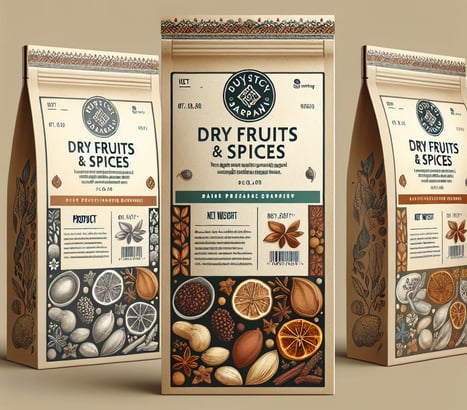"Unlock the secrets to smart investing and stay informed on the latest trends in Indian business and finance."
Leo Dry Fruits and Spices IPO Details
If you are seeking a promising investment opportunity, investing in this company could be a good option.
CA Narendra Rajpoot
1/3/202510 min read
1. About the company..
Leo Dry Fruits and Spices Trading manufactures, processes, trades and markets products such as spices, dry fruits, and other grocery items under the 'VANDU' brand, as well as frozen and semi-fried product under the ''FRYD'' brand. The company offers whole and blanded spices, plain, roasted, and flavoured dry fruits, along with products such as ghee, seasoning, poppy seeds, and sesame seeds, among others, in different packing sizes. The business operates across two key verticals:trading and manufacturing/processing. In the trading division the company deals with bulk and smaller quantities of whole spices, dry fruits, and frozen/semi-fried products. In the manufacturing/processing division, the company focuses on blended spices and other grocery items like ''chiz bites'' and seasoning, which are processed at the company's facility.




2. Strengths
Leo Dry Fruits and Spices Trading operates a manufacturing and processing unit that holds an FSSAI license under the Food Safety and Standards Act,2006.
In the B2C segment, the company engages in retail by offering whole spices, blended spices, dry fruits, and other grocery products under the ''VANDU'' brand. These products are distributed through various channels, including distributors, super stockists, e-commerce platforms like Amazon and Flipkart, and the company's own website.
The company claims that it is equipped with modern machinery and facilities that enable the hygienic processing, grading and packaging of its manufactured spices.
The company has seen a consistent increase in revenue from operations and profit after tax(PAT). Revenue from operations increased from Rs.5.26 crore in FY22 to Rs.36.44 crore in FY23 to Rs. 62.16 crore in FY24. PAT increased from Rs.0.08 crore in FY22 to Rs.3.63 crore in FY23 to Rs.6.64 crore in FY24.


3. Risks
The company, its promoter and directors are currently involved in certain ongoing legal proceedings. Any adverse judgements in any of these cases could be detrimental to the company's business prospects.
The company does not own the ''VANDU'' trademark. The company has entered into a trademark license agreement with a firm owned by one of its promoters, Ketan Sobhagchand Shah, to use the trademark ''VANDU'' for a royalty payment of Rs. 25,000 per annum.
The promoter group entities Sobhagchand & Sons, K K Corporation, J Ketankumar Co, K Sobhagchand Co and V S Spices are engaged in similar line of business - primarily spices, grains and other grocery products. This could create a conflict of interest in the future.
A major portion of the company's revenue comes from trading activities. This segment contributed Rs.14.15 crore(79.15%) for the period ending September 30,2024, and Rs. 47.97 crore (77.17%), Rs.31.59 crore(86.70%), and Rs.5.26 crore(100%) in FY24, FY23, and FY22, respectively, to the revenue from operations. The company has to rely on third parties for the sourcing of the products. Any quality issues, unfavorable vendor terms, or changes in vendor strategies could adversely affect the company's business operations and finances.
A substantial's portion of revenue is generated from a small group of customers. The top 10 customers contributed Rs.16.60 crore (93.32%) for the period ending September 30,2024 and Rs.27.53 crore(44.29%), Rs.15.62 crore(42.87%), and Rs.4.85 crore(92.21%) in FY24,FY23, and FY22, respectively, to the revenue from operations. Any loss of any major customer or a decline in business from them could adversely impact the company's operations and financial performance.
The company relies heavily on its manufacturing and processing unit. Any sudden shutdown or failure to maintain or repair critical machinery could disrupt operations and affect the company's overall performance.
The Maharashtra region accounted for over 90% of the company's revenue in the last three financial years. Any adverse developments in the region could hit the company's business operations. Also, failure, to expand into new geographic markets could limit the company's growth.
As of September 30,2024, the company had total borrowings, including short term and long term debt, amounting to Rs.16.70 crore. Any inability to repay or service these loans could adversely affect the company's financials position.


4. About the Financials
Net profit - Net profit of the company is increasing consistently and significantly. In Mar2022 Net profit of the company was Rs.0.08 crore and in Mar2023 net profit of the company was Rs. 3.63 crore and in Mar2024 net profit was Rs.6.64 crore.
The company has experienced significant and consistent growth in net profit over the past three years. From Rs. 0.08 crore in March 2022, it rose to Rs. 3.63 crore in March 2023, and further increased to Rs. 6.64 crore in March 2024. This indicates strong financial performance and an upward trajectory in profitability.
Fixed Assets - Fixed Assets of the company is increasing consistently and significantly. In Mar2022 Fixed Assets of the company was Rs.3.82 crore and in Mar2023 Fixed Assets of the company was Rs. 4.25 crore and in Mar2024 Fixed Assets was Rs.4.03 crore.
The company's fixed assets have shown consistent growth, though with some fluctuation. From Rs. 3.82 crore in March 2022, they increased to Rs. 4.25 crore in March 2023. However, in March 2024, the fixed assets slightly decreased to Rs. 4.03 crore. Despite this minor decline, the overall trend suggests a stable investment in long-term assets, indicating the company's commitment to expanding its operational capacity.
Inventories - Inventories of the company is increasing consistently and significantly. In Mar2022 Inventories of the company was Rs.3.77 crore and in Mar2023 Inventories of the company was Rs. 13.02 crore and in Mar2024 Inventories was Rs.23.64 crore.
The company has experienced significant and consistent growth in its inventories over the past three years. From Rs. 3.77 crore in March 2022, inventories increased to Rs. 13.02 crore in March 2023, and further rose to Rs. 23.64 crore in March 2024. This substantial growth indicates that the company is significantly expanding its stock, which could be a result of increased production, higher sales expectations, or strategic inventory buildup to meet future demand.
Trade Receivables - Trade Receivables of the company is increasing consistently and significantly. In Mar2022 Trade Receivables of the company was Rs.2.78 crore and in Mar2023 Trade Receivables of the company was Rs. 7.40 crore and in Mar2024 Trade Receivables was Rs.22.40 crore.
The company's trade receivables have shown significant and consistent growth over the past three years. From Rs. 2.78 crore in March 2022, trade receivables increased to Rs. 7.40 crore in March 2023, and further surged to Rs. 22.40 crore in March 2024. This substantial rise suggests that the company is experiencing increased sales, but it may also indicate a higher volume of outstanding payments from customers. While this growth reflects strong business activity, it also warrants attention to ensure efficient receivables management and timely collection.
Cash and Cash Equivalents - Cash and Cash Equivalents of the company is increasing consistently and significantly. In Mar2022 Cash and Cash Equivalents of the company was Rs.0.77 crore and in Mar2023 Cash and Cash Equivalents of the company was Rs. 0.12 crore and in Mar2024 Cash and Cash Equivalents was Rs.0.16 crore.
The company's cash and cash equivalents have shown a slight increase over the past three years, growing from Rs. 0.77 crore in March 2022 to Rs. 0.12 crore in March 2023, and further to Rs. 0.16 crore in March 2024. Despite the increase, the amounts remain relatively low, which could indicate that the company is either investing its cash in other areas or relying more on credit and receivables. The low level of cash reserves might require attention to ensure sufficient liquidity for day-to-day operations and unforeseen expenses.
Reserves - Reserves of the company is increasing consistently and significantly. In Mar2022 Reserves of the company was Rs.0.07 crore and in Mar2023 Reserves of the company was Rs. 3.70 crore and in Mar2024 Reserves was Rs.20.84 crore.
Reserves of the company is increasing consistently and significantly. In Mar2022 Reserves of the company was Rs.0.07 crore and in Mar2023 Reserves of the company was Rs. 3.70 crore and in Mar2024 Reserves was Rs.20.84 crore.
Borrowing - Borrowing of the company is increasing consistently and significantly. In Mar2022 Borrowing of the company was Rs.6.01 crore and in Mar2023 Borrowing of the company was Rs. 15.37 crore and in Mar2024 Borrowing was Rs.9.15 crore.
The company's borrowing has shown significant fluctuations over the past three years. From Rs. 6.01 crore in March 2022, it increased to Rs. 15.37 crore in March 2023, before decreasing to Rs. 9.15 crore in March 2024. The sharp increase in borrowing in 2023 suggests the company may have taken on additional debt for expansion or other strategic purposes, while the decrease in 2024 could reflect repayment efforts or a reduction in financing needs. Overall, while borrowing has been a key source of funds, managing the debt level will be crucial for maintaining financial stability.
Other Liabilities - Other Liabilities of the company is increasing consistently and significantly. In Mar2022 Other Liabilities of the company was Rs.4.60 crore and in Mar2023 Other Liabilities of the company was Rs. 6.27 crore and in Mar2024 Other Liabilities was Rs.9.30 crore.
The company's other liabilities have shown consistent and significant growth over the past three years. From Rs. 4.60 crore in March 2022, other liabilities increased to Rs. 6.27 crore in March 2023, and further rose to Rs. 9.30 crore in March 2024. This steady increase suggests that the company may be taking on more short-term obligations or incurring additional liabilities related to its operations. While growth in liabilities may indicate expanding business activities, it is important for the company to manage these obligations effectively to ensure long-term financial health.




5. Cash Flow
Cash from Operating Activity - Cash from operating activity is decreasing significantly. In Mar2022 Cash from Operating Activity was Rs.(-2.70 crores) and In Mar2023 Cash from Operating Activity was Rs.(-8.18 crores) and In Mar2024 Cash from Operating Activity was Rs.(-14.57 crores).
The company's cash from operating activities has been consistently negative and has significantly worsened over the past three years. From Rs. (-2.70 crore) in March 2022, it deepened to Rs. (-8.18 crore) in March 2023, and further declined to Rs. (-14.57 crore) in March 2024. This indicates that the company is facing difficulties in generating sufficient cash from its core operations, which could be due to high operating expenses, lower profitability, or inefficiencies in cash management. This trend may raise concerns about the company's ability to sustain operations without relying on external financing or changes in its operational structure.
Cash from Investing Activity - In Mar2022 Cash from Investing Activity was Rs.(-3.82 crores) and In Mar2023 Cash from Investing Activity was Rs.(-1.39 crores) and In Mar2024 Cash from Investing Activity was Rs.(-0.29 crores).
The company’s cash from investing activities has shown a decreasing trend in negative cash outflows over the past three years. From Rs. (-3.82 crore) in March 2022, it improved to Rs. (-1.39 crore) in March 2023, and further improved to Rs. (-0.29 crore) in March 2024. Although the company is still investing, the reduction in negative cash flow suggests that its investment activities are becoming more efficient, potentially due to fewer or smaller investments in assets or more selective capital expenditures. This could indicate better management of investments and a focus on improving cash flow in the long term.
Cash from Financing Activity - In Mar2022 Cash from Financing Activity was Rs.7.30 crores and In Mar2023 Cash from Financing Activity was Rs.8.92 crores and In Mar2024 Cash from Financing Activity was Rs.14.90 crores.
The company's cash from financing activities has shown a consistent increase over the past three years. From Rs. 7.30 crore in March 2022, it rose to Rs. 8.92 crore in March 2023, and further increased to Rs. 14.90 crore in March 2024. This steady growth indicates that the company has been relying more on external financing, such as loans or equity raises, to fund its operations or expansion. While this helps support growth, the increasing reliance on financing may raise concerns about the company’s ability to generate sufficient cash from operations in the future and could lead to higher debt obligations.


6. Ratios
Debtor Days - Debtor days was 192 days in Mar2022 and Debtor days was 74 days in Mar2023 and Debtor days was 131 days in Mar2024.
The company's debtor days have fluctuated over the past three years. From 192 days in March 2022, it improved significantly to 74 days in March 2023, indicating better efficiency in collecting payments from customers. However, in March 2024, debtor days increased again to 131 days, suggesting a slowdown in receivables collection. While the company had made significant progress in 2023, the rise in debtor days in 2024 could indicate potential challenges in managing accounts receivable or delayed payments from customers, which may impact cash flow and liquidity.
Inventory Days- Inventory Days was 269 days in Mar2022 and Inventory Days was 166 days in Mar2023 and Inventory Days was 180 days in Mar2024.
The company's inventory days have shown a decline and then a slight increase over the past three years. From 269 days in March 2022, inventory days reduced to 166 days in March 2023, reflecting improved efficiency in inventory management and faster turnover. However, in March 2024, inventory days rose to 180 days, indicating a slight slowdown in inventory movement. While the reduction in inventory days in 2023 suggests better inventory control, the increase in 2024 could point to potential issues in sales or inventory management that may require attention to maintain optimal efficiency.
Days Payable - Days Payable was 314 days in Mar2022 and Days Payable was 49 days in Mar2023 and Days Payable was 45 days in Mar2024.
The company's days payable has significantly decreased over the past three years. From 314 days in March 2022, it sharply declined to 49 days in March 2023, and further reduced to 45 days in March 2024. This indicates that the company has improved its efficiency in paying its suppliers, likely leading to better supplier relationships and possibly more favorable payment terms. However, the substantial reduction from 2022 to 2023 could also suggest that the company is managing its cash flow more tightly or has a greater focus on timely payments, which could impact working capital management.
Cash Conversion Cycle - Cash Conversion Cycle was 148 days in Mar2022 and Cash Conversion Cycle was 190 days in Mar2023 and Cash Conversion Cycle was 266 days in Mar2024.
The company's cash conversion cycle has steadily increased over the past three years. From 148 days in March 2022, it rose to 190 days in March 2023, and further increased to 266 days in March 2024. This suggests that the company’s overall efficiency in converting its investments in inventory and receivables back into cash has deteriorated. The rising cash conversion cycle indicates that it is taking longer for the company to sell inventory, collect receivables, and pay off its payables, which could put pressure on its working capital and liquidity. This trend requires attention to improve cash flow management and operational efficiency.
Working Capital Days - Working Capital Days was 192 days in Mar2022 and Working Capital Days was 155 days in Mar2023 and Working Capital Days was 225 days in Mar2024.
The company's working capital days have shown fluctuations over the past three years. From 192 days in March 2022, it improved to 155 days in March 2023, indicating better efficiency in managing working capital. However, in March 2024, working capital days increased to 225 days, suggesting a slowdown in the company’s ability to manage its short-term assets and liabilities effectively. The increase in 2024 may indicate a rise in inventory, receivables, or a delay in paying off payables, which could strain liquidity and require attention to optimize working capital management.
ROCE % - In Mar2023 ROCE % was 41.80% and In Mar2024 ROCE % was 33.84%
The company's Return on Capital Employed (ROCE) has decreased from 41.80% in March 2023 to 33.84% in March 2024. This decline suggests that while the company is still generating a strong return on its capital, the efficiency in utilizing its capital to generate profits has reduced. The decrease in ROCE may be due to lower profitability, increased capital investments, or other factors affecting operational efficiency. It is important for the company to assess and improve its capital utilization to maintain strong returns moving forward.


